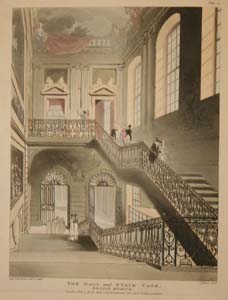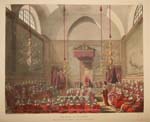Rudolph Ackermann

Rudolph Ackermann (1764-1834) was a German immigrant to England and one of the most important figures in the history of color plate books. He was born in Stollberg, near Leipzig in Saxony, and moved to England at age 23. Before he became part of the publishing world, Ackermann designed carriages, and he was employed for some time in Paris by the celebrated carriage maker Antoine Carassi. Ackermann was the first to recognize the commercial possibilities of aquatint, and effectively launched this very English type of illustration. He also started the English trend for gift books in the 1820s, a trend which continued well into the early 20th century. Throughout his career, Ackermann would commission and publish many great color plate books, many of which are still sought after today.
In 1797 Ackermann moved his business to 101 Strand (known as 'The Repository of Arts' from 1798), where in addition to his publishing business he housed the only public library for the arts in London. 1808 and 1809 were breakthrough years, as they saw the first issue of two publications which secured Ackermann's reputation as a publisher of the finest color plate books: The Microcosm of London and The Repository of Arts, a monthly magazine of fashion and social and literary news, which began in 1809 and continued for twenty years, during which time it featured 1432 hand-colored plates. The Repository of Arts was also important because it, along with the Poetical Magazine, helped to compensate for the fact that Ackermann did not make a profit on all his major projects.
Ackermann was a creative and efficient publisher, who brought innovative techniques to the commercial production of color plate books as well as an uncompromising attention to detail which ensured uniform high quality. In addition to books, Ackermann published many decorative hand-colored prints, including over 100 political and social caricatures by and after Thomas Rowlandson. Ackermann also oversaw a workshop where the prints he produced were colored. His print shop also supplied the color for all the colored plates in the books he published. In general, the color from his workshop was applied with deftness and delicacy, which indicates that he probably trained workers for the purpose. During the time of the French Revolution, many of these workers were French émigrés.

This is one of the great color plate books of all time and a cornerstone of any collection. It appeared from 1808 to 1810 in parts and contains 104 hand-colored aquatints. 1,000 copies were printed. The illustrations were done by Thomas Rowlandson, who supplied the figures, and Auguste Pugin, who drew the architecture. The reason for using two separate artists is given in the books Preface, which explains that the objections made to engravings of architecture are generally due to the fact that "the buildings and figures have almost invariably been designed by the same artists. In consequence of this, the figures have been generally neglected, or are of a very inferior cast" (ii-iii). The illustrations show all the well-known public buildings in London of the time, and represent scenes from both high and low life. In addition to their abundant aesthetic value, many of the places portrayed no longer exist, and the plates are thus valuable as historical representations.
